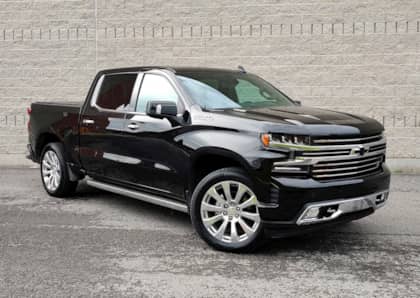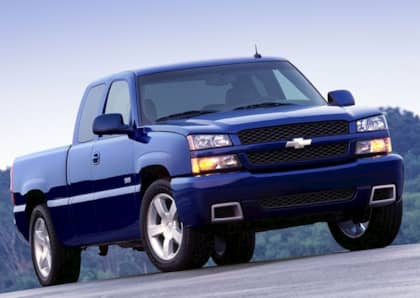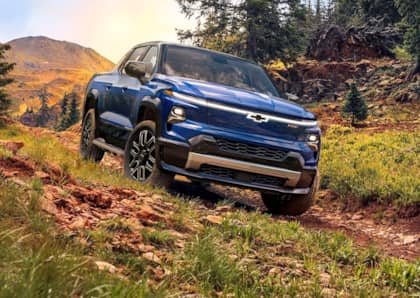Was The Chevrolet SSR Sport Truck Really All That Bad?
Sometimes, automotive experiments don't get a second act. This is especially true if they spring forth from General Motors, a company that developed a reputation for beta-testing technology in the showroom rather than waiting to deliver a fully-baked vehicle.
Few people remember that Chevy was able to work out the Corvair's suspension bugs and present a much safer design in its second generation, as the lingering stink of its botched launch and negative Nader publicity obscured any potential bright spots. Likewise the Pontiac Fiero's quick descent into the butt of firetrap jokes couldn't be lifted by the excellent drivetrain update that would make later models a legitimate, yet ignored entry on the sports car scene.

When the Chevrolet SSR debuted as a 2003 model, few would have pegged it to continue this long-standing GM tradition. The retro-styling craze was in full swing, and the idea of a muscle truck whose lines were lifted straight out of the 1950s felt like a guaranteed home run for Chevy's limited-production aspirations. Unfortunately, it was not meant to be. Stumbling out of the gate, the SSR would meet with general apathy from its target market, dooming it to ignominy that not even a midnight-hour heart transplant could remedy.
Was it really all that bad? Or is the SSR due for an image rehabilitation project 17 years after it first debuted?
Sign Of The Times
Seen from a modern perspective, there's a lot about the SSR that no longer makes a lot of sense. The idea of building a roadster pickup truck whose cargo bed was more useful in storing its retractable steel roof than it was at hauling anything practical comes across as commercial suicide, the auto industry equivalent of a punk rock band pivoting to Muzak covers for their second album.
Consider the circumstances of its birth, however, and Chevy's passion project starts to make a lot more sense. This was the same era that gave us the runaway sale success that was the Chrysler PT Cruiser, a cheap-to-build, nostalgia-infused panel wagon cobbled together from bits and pieces of the brand's econo-platforms, as well as the Volkswagen New Beetle, itself a re-skinned Golf, and the from-left-field Plymouth Prowler. Copycats would follow in the form of the entry-level Chevrolet HHR and the largely unloved Ford Thunderbird, each of which wore their blast-from-the-past looks as a badge of honor.
Where's The Beef?
If you're not first, you can't rely on novelty to power your sales machine. Instead, you've got to deliver something of substance, ideally in the form of a driving experience that backs up the looks that initially drew buyers into the showroom. Here's where the SSR fell the hardest. It's one thing to give up utility in the face of style, but it's entirely another to be boring from behind the wheel at the same time.

Much of the blame can be shouldered by the 5.3-liter V8 Chevrolet dumped under the SSR's hood. Rated at a competent, but uninspiring 300 horsepower, and matched to a similarly-tepid four-speed automatic transmission, it was a drivetrain that failed to follow through on the converti-truck's visual promise of excitement. We’re talking a full 7 seconds to reach 60 mph, and a quarter mile ET in the mid-15 second range. Not exactly the stuff that dreams are made of, and it showed in dismal sales figures that failed to reach even Chevrolet's modest predictions for the niche truck.
Second Wind
Help was on the way for 2005, which is when the SSR began its mea culpa power tour. Abandoning the cost-focused strategy that had guided the vehicle's original design (the weak V8 was part-and-parcel of its sharing the GMT368 platform with a host of anonymous in-house SUVs), Chevrolet elected to transplant a mightier 6.0-liter V8 that had been tuned to provide 390 horsepower and 405 lb-ft of torque. Not only that, but the same unit could be matched with an optional six-speed automatic transmission, and an additional five ponies made it onto the window sticker for 2006.

This changed everything. With a third pedal in the mix, and all that juicy LS2 torque dripping from the dyno sheet, the SSR sliced a full two seconds from its sprint to 60-mph, finally giving it the 5 seconds flat performance it needed to thrill drivers. The quarter mile now disappeared in a much quicker 14 seconds (a number that still reflected the Chevrolet's porky 4,700 lbs of curb weight). The added engagement of the six-speed was a further bonus, as it dramatically transformed the truck from lethargic cruiser to genuine tire-shredder.
As with every other last-ditch effort to turn around a sinking GM offering, the sport truck's makeover simply came too late. Very few stuck around to sample SSR Part II, especially given that its sales price could balloon to nearly $50k with options. Only 24,000 were ever built, and after the retro wave had crested it slunk off somewhere into the endless summer to die in peace.
Rose-Colored Glasses?
Today, the SSR presents an intriguing choice for hot rod fans who want to drive something different, but don't want to let go of their mod-cons in the process. With such a vast aftermarket available for the LS engine, even the dull 5.3 can be heated up well past its stock limits for relatively little money, offering respectable power for secondhand buyers willing to get a little grease under their fingernails.

If you don't want to do any heavy lifting, then the 6.0-liter model represents an even more appealing buy. While most other go-quick trucks from the same era - such as the Trailblazer SS - have been beaten down by their third and fourth owners by this point, it's easier to find a good condition SSR. With excellent condition examples ranging from $25,000 to $35,000, depending on the year (with later models commanding a premium), Chevrolet's most unusual pickup remains an appealing way to let your freak fiberglass flag fly.
Would Ford have found success with its own retro rig? Check out the 2004 Ford Bronco conept that never made it to showrooms.











